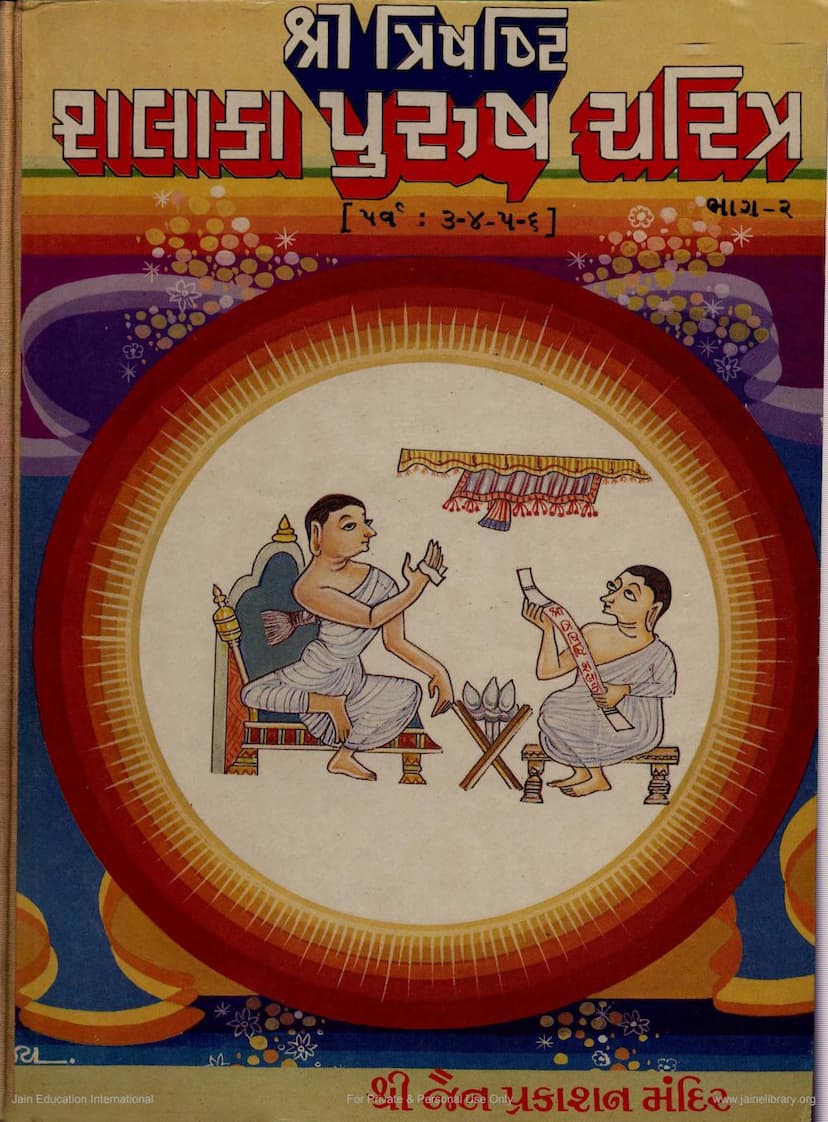Trishasti Shalaka Purusa Caritra Part 2
Added to library: September 2, 2025

Summary
Here's a comprehensive summary of the provided Jain text, "Trishasti Shalaka Purusa Charitra Part 2," based on the Gujarati pages:
The text is the second part of the Trishasti ShalAka Purusha Charitra, compiled by Hemchandracharya and published by Jain Prakashak Mandal, Ahmedabad. This specific volume covers Parva (Book/Section) 3 through 6, and includes forty-five characters in total.
Key Content and Structure:
This volume focuses on the biographies of several significant figures in Jainism, organized into distinct "Parva" sections:
-
Parva 3 (Third Section): This section covers the lives of the 3rd to the 8th Tirthankaras, detailing the biographies of six Tirthankaras and the lineages of seven Vasudevas, seven Baladevas, and seven Prativāsudevas, totaling 45 biographies. It specifically includes the characters from Shri Sambhavnathji to Shri Munisuvrat Swamiji.
-
Parva 4 (Fourth Section): This section describes the lives of the 9th to the 14th Tirthankaras. It also includes the biographies of the third Madhava Chakravarti and the fourth Sanat Kumar Chakravarti.
-
Parva 5 (Fifth Section): This section is dedicated to the life of Shri Shantinathji, the 16th Tirthankara. It includes a detailed account of his twelve previous lives (bhavas), highlighting his spiritual journey and the accumulation of meritorious karma that led to his Tirthankara status. It also includes the biography of his son and first Ganadhara, Chakrayudh.
-
Parva 6 (Sixth Section): This part covers the lives of the 17th to the 18th Tirthankaras, specifically Shri Kunthunathji and Shri Aranatha. It also details the biographies of the sixth Vasudeva, Baladeva, and Prativāsudeva (Purushapundrik, Anand, and Maliraja), the eighth Chakravarti Sumati, and the seventh Vasudeva, Baladeva, and Prativāsudeva (Datta, Nandan, and Prahlada). It further includes the life stories of Shri Mallinath and Shri Munisuvrat Swami, detailing their previous lives and significant events. The section on Shri Munisuvrat Swami also touches upon the origin of the Harivamsa lineage and the story of Kartik Shreni.
-
Contents of the Table of Contents (Vishayanukramanika) for Parva 3: This indicates a detailed breakdown of the narratives, including:
- Biographies of Tirthankaras (Sambhavnath, Abhinandan, Sumatinath, Padmaprabh, Suparshvanath, Chandrapraabh, Suvidhinath, Shitalnath).
- Biographies of Vasudevas, Baladevas, and Prativāsudevas.
- Biographies of Chakravartis.
- The text highlights specific narratives within these biographies, such as the story of King Vipulavahana during a famine (Parva 3, Chapter 1), King Vipulavahana's devotion to the Sangh, King Vipulavahana's reflections on the impermanence of the world (Sarga 1, Chapter 2), King Vipulavahana's decision to take diksha, the birth of Lord Sambhavanath, Indra's hymns, and the teachings (deshna) of the Tirthankaras on various philosophies like impermanence, helplessness, oneness, worldly transience, impurity, inflow of karma, stopping of karma, and the rarity of dharma and enlightenment.
Overall Purpose and Significance:
The "Trishasti Shalaka Purusha Charitra" is a monumental work in Jain literature, serving as a comprehensive account of the sixty-three great souls (Shalaka Purushas) who shape the Jain universe. Part 2, as presented in these pages, continues this epic narrative, providing:
- Detailed Biographies: The text offers in-depth life stories of Tirthankaras, Chakravartis, Vasudevas, Baladevas, and Prativāsudevas, covering their past lives, significant events, and teachings.
- Spiritual and Moral Teachings: Embedded within the narratives are profound Jain philosophical and ethical teachings, such as the impermanence of life, the importance of detachment, the consequences of karma, the path to liberation, and the principles of right conduct.
- Historical and Mythological Context: It provides a glimpse into the historical and mythological framework of Jain cosmology and the lives of revered figures, offering insights into Jain beliefs and practices.
- Literary Merit: The author, Hemchandracharya, is renowned for his scholarly and poetic brilliance, evident in the detailed descriptions and eloquent language used to narrate these extraordinary lives.
In essence, this volume of the Trishasti Shalaka Purusha Charitra is a rich repository of Jain history, philosophy, and literature, dedicated to illuminating the lives and teachings of the most revered figures in the Jain tradition.